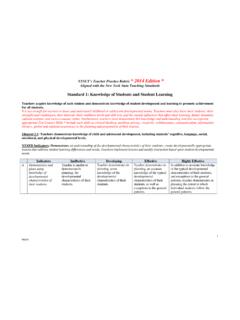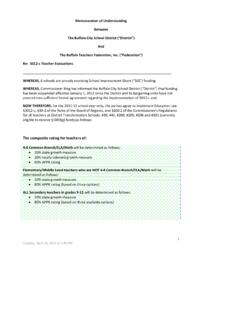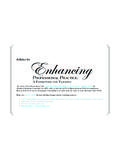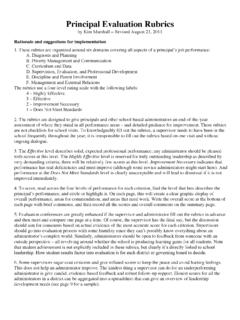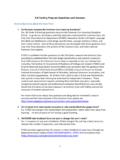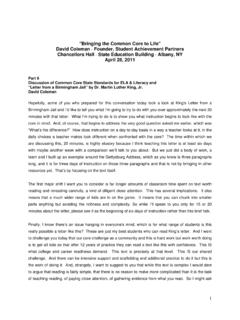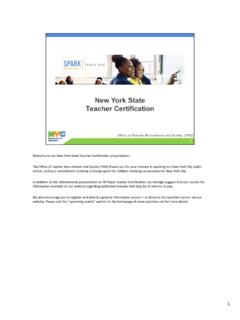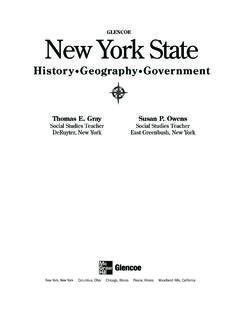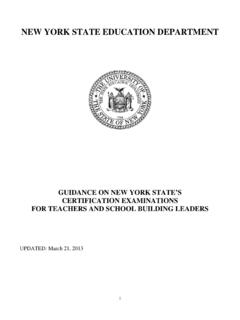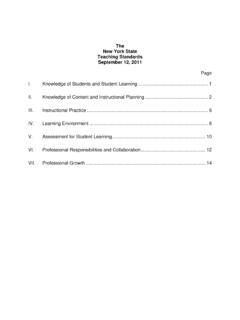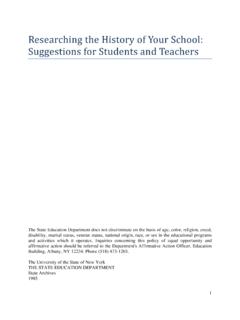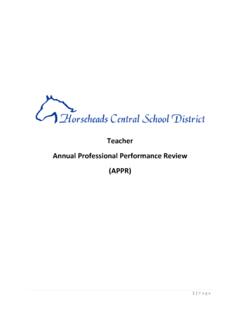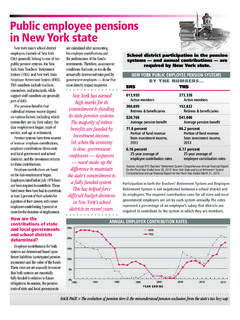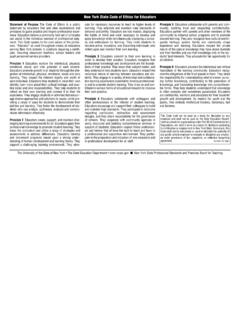Transcription of NYSUT’s Teacher Practice Rubric - New York State ...
1 NYSUT s Teacher Practice Rubric * 2012 edition * Aligned with the New york State Teaching Standards 90163 Approved by the NYS Education Department August 2012 1 Standard 1: Knowledge of Students and Student Learning Teachers acquire knowledge of each student and demonstrate knowledge of student development and learning to promote achievement for all students. It is not enough for teachers to know and understand childhood or adolescent developmental norms. Teachers must also know their students: their strengths and weaknesses, their interests, their readiness levels and skill sets, and the outside influences that affect their learning: family dynamics, cultural customs, and socio-economic status.
2 Furthermore, teachers must demonstrate this knowledge and understanding and also incorporate appropriate 21st Century Skills in the planning and preparation of their lessons. Element : Teachers demonstrate knowledge of child and adolescent development, including students cognitive, language, social, emotional, and physical developmental levels. NYSED Indicators: Describe orally and in writing an understanding of the developmental characteristics of their students; create developmentally appropriate lessons that address student learning differences and needs; Teachers implement lessons and modify instruction based upon student developmental needs. Indicators Ineffective Developing Effective Highly Effective A.
3 Describes and plans using knowledge of developmental characteristics of students Teacher is unable to describe orally or apply in planning, the developmental characteristics of the age group. Teacher describes orally and applies in planning, some knowledge of the developmental characteristics of the age group. Teacher describes orally and applies in planning, an accurate knowledge of the typical developmental characteristics of the age group, as well as exceptions to the general patterns. In addition to accurate knowledge of the typical developmental characteristics of the age group, and exceptions to the general patterns, Teacher describes orally and applies in planning the extent to which individual students follow the general patterns and how 21st Century Skills fit into this knowledge base.
4 NYSUT s Teacher Practice Rubric * 2012 edition * Aligned with the New york State Teaching Standards 90163 Approved by the NYS Education Department August 2012 2 Element : Teachers demonstrate current, research-based knowledge of learning and language acquisition theories and processes. NYSED Indicators: Design lesson plans and adjust instruction to include a variety of strategies that support the learning needs of each student. Design lesson plans and adjust instruction to include a variety of strategies that support the language acquisition needs of each student. Teachers explain their instructional decisions citing current research.
5 Indicators Ineffective Developing Effective Highly Effective A. Uses strategies to support learning and language acquisition Teacher designs lessons with few strategies that support student learning and language acquisition needs. Teacher does not adjust instruction. Teacher designs lessons to include some instructional strategies that support the learning and language acquisition needs of some students. Teacher is able to adjust instruction by implementing one or two additional strategies. Teacher designs lessons to include several instructional strategies that support the learning and language acquisition needs of most students. Teacher is able to adjust instruction by adapting and/or adding strategies to meet the needs of specific students.
6 Teacher designs lessons to include several instructional strategies that support the learning and language acquisition needs of each student. Teacher is able to adjust instruction by adapting and/or adding strategies to meet the needs of specific students. Students suggest specific strategies that help them achieve the outcomes of the lesson and Teacher supports the students suggestions. B. Uses current research Teacher is unable to cite current research to plan or explain instructional decisions. Teacher cites limited or dated research to plan and explain instructional decisions. Teacher cites current research to plan and explain instructional decisions. Teacher cites current research to plan and explain instructional decisions and seeks out additional research to inform Practice .
7 NYSUT s Teacher Practice Rubric * 2012 edition * Aligned with the New york State Teaching Standards 90163 Approved by the NYS Education Department August 2012 3 Element : Teachers demonstrate knowledge of and are responsive to diverse learning needs, strengths, interests, and experiences of all students. NYSED Indicators: Vary and modify instruction to meet the diverse learning needs of each student. Create, deliver, and adapt instruction to address each student s strengths, interests, and experiences. Indicators Ineffective Developing Effective Highly Effective A. Plans for student strengths, interests, experiences to meet diverse learning needs of each student Teacher s plans do not vary or modify instruction to meet the strengths, interests, experiences, or diverse learning needs of students.
8 Teacher s plans vary or modify instruction to meet the strengths, interests, experiences, and diverse learning needs of some students. Teacher s plans vary or modify instruction to meet the strengths, interests, experiences, diverse learning needs of most students. Teacher s plans vary or modify instruction to meet the strengths, interests, experiences, diverse learning needs of each student. Students suggest ways in which the lesson might be modified to advance their own learning and Teacher acknowledges the suggestion. NYSUT s Teacher Practice Rubric * 2012 edition * Aligned with the New york State Teaching Standards 90163 Approved by the NYS Education Department August 2012 4 Element : Teachers acquire knowledge of individual students from students, families, guardians, and/or caregivers to enhance student learning.
9 NYSED Indicators: Communicate directly with each student s parents, guardians, and/or caregivers. Use a variety of techniques to accommodate the communication needs of each student s parents, guardians, and/or caregivers. Indicators Ineffective Developing Effective Highly Effective A. Communicates with parents, guardians, and/or caregivers. Teacher does not communicate directly with student s parents, guardians, and/or caregivers to enhance student learning and/or does not accommodate the communication needs of the family. Teacher occasionally communicates directly with student s parents, guardians, and/or caregivers to enhance student learning. Communication is occasionally modified to meet the needs of the family.
10 Teacher regularly communicates directly with student s parents, guardians, and/or caregivers to enhance student learning. Communication is frequent and uses multiple modes of contact to accommodate the needs of the family. Teacher communicates directly with student s parents, guardians, and/or caregivers to enhance student learning. Multiple modes of contact are used to accommodate the needs of the family. Students and parents/guardians initiate communication. NYSUT s Teacher Practice Rubric * 2012 edition * Aligned with the New york State Teaching Standards 90163 Approved by the NYS Education Department August 2012 5 Element : Teachers demonstrate knowledge of and are responsive to the economic, social, cultural, linguistic, family, and community factors that influence their students learning.
